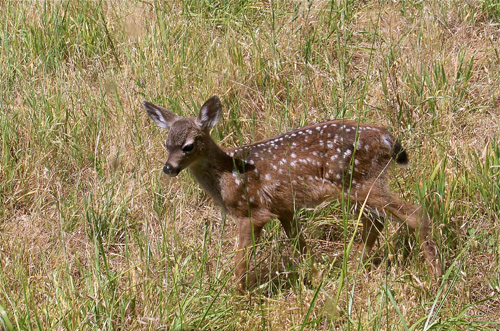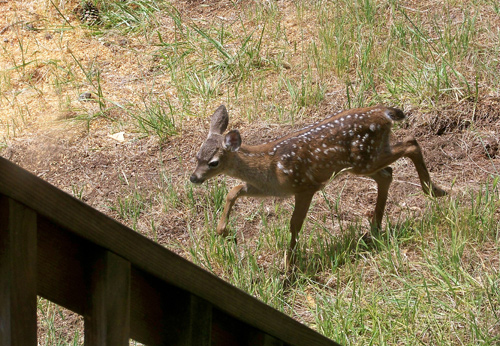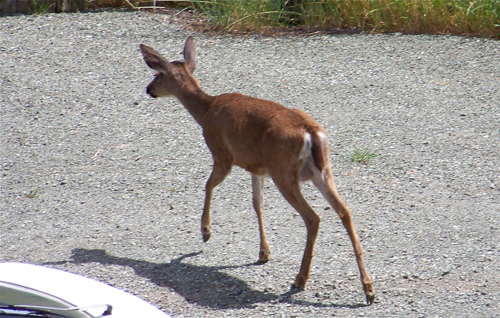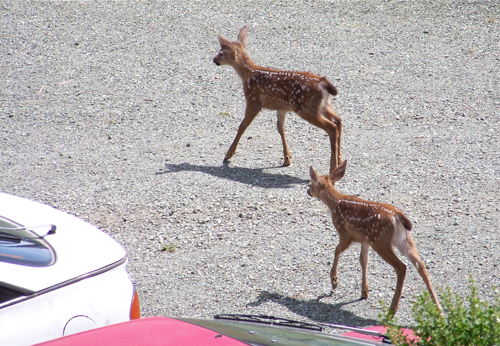Sun 18 May 2014
My deer friends
Posted by DavidMitchell under West Marin nature, Wildlife
1 Comment
Lynn looked out the kitchen window Thursday morning in time to see a doe and two fawns grazing only a few feet away. Immediately, I grabbed my camera.
The spots suggest the fawns are only about a month old.
Our word “deer” comes from the Old English word “deor,” which referred to animals in general, of course, including deer. In Middle English, the language of Chaucer (c.1343-1400), the word was spelled “der,” and the American Heritage Dictionary notes it could refer to all manner of creatures, including “a fish, an ant, or a fox.”
Even in the plays of Shakespeare (1564-1616), who wrote in Modern English (albeit of the Elizabethan variety), the meaning of the word remains uncertain. In King Lear, Act III, scene iv, the Earl of Gloucester’s much-abused son Tom ‘o Bedlam (disguised as Edgar) laments, “Mice and rats, and such small deer,/ Have been Tom’s food for seven long year.”
To our surprise, the fawns soon trotted under Mitchell cabin’s deck but before long emerged from the far side.
All three major deer species native to North America (blacktail, whitetail, and mule) trace their ancestry back to a primordial, rabbit-size Odocoileus, which had fangs and no antlers and lived around the Arctic Circle some 10 million years ago,” Bruce Morris writes in Bay Nature.
Whitetails first appeared on the East Coast about 3.5 million years ago, as this blog previously noted. DNA evidence suggests they spread south and then west, arriving in Southern California about 1.5 million years ago.
In moving up the coast, whitetails evolved into blacktails, which resemble them in appearance and temperament.
The fawns soon followed their mother (note hoof at left) away from the cabin.
The blacktails eventually spread inland, meeting up with more whitetails coming from the east. Apparently the blacktail bucks were able to horn in on the harems of their parent species.
DNA tests have determined that mule deer, which are found from the Northwest to the deserts of the Southwest and as far east as the Dakotas, are a hybrid of whitetail does and blacktail bucks, author Valerius Geist writes in Mule Deer Country.
The doe crossed our parking area keeping an eye out for any threat to her fawns.
Columbian blacktail deer (Odocoileus hemionus columbianus) are the subspecies of blacktails native to West Marin and the rest of the San Francisco Bay Area. The California Department of Fish and Game a few years back estimated there were approximately 560,000 deer in all of California, about 320,000 of which were Columbian blacktails.
“Blacktails have a typical lifespan in the wild of seven to 10 years, but they can survive in suburban habitat for as long as 17 to 20 years if unmolested,” Morris notes in Bay Nature. “Suburban deer have minuscule home ranges, measuring three or four blocks for females whereas wild deer inhabit territories that extend for several miles.”
The fawns walked behind our cars as they followed close behind the doe.
Mountain lions, and occasionally bobcats and coyotes, prey on deer, but the biggest threat to West Marin’s blacktails are motor vehicles. In fact, being struck by automobiles is the biggest cause of deer fatalities nationwide: more than one million a year.
More surprising is the number of deer struck by airplanes, an average of one a week nationwide. Or so says Benner’s Gardens, which makes deer-fencing systems.
One last bit of deer trivia: “The male deer is usually called a buck, but the male red deer of Europe is a stag, or when mature a hart, [and] the female is called a hind or doe,” to quote the Encyclopedia Americana.






I miss terribly the graceful Fallow and Axis deer. I guess “reducing their numbers” means “wiping out”. What a shame.